Types of Spiders in California (With Pictures) — Identification Guide
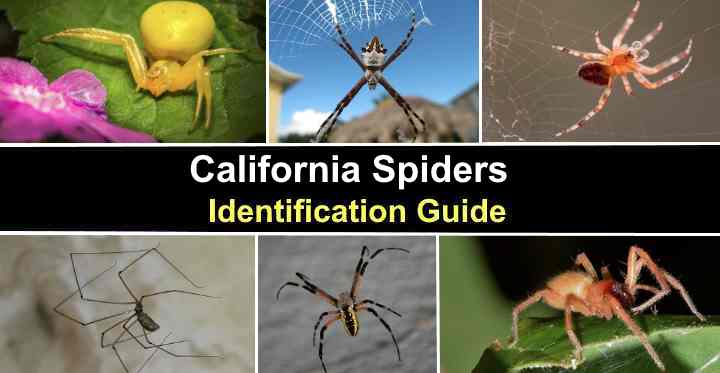
Spiders are a common sight in California. And the Bear Flag State is home to a wide range of arachnids, most of which are harmless, but some are venomous and can inflict a nasty bite. Common species of spiders in California you might spot outdoors are tarantulas, wolf spiders, yellow and black garden spiders, and jumping spiders. Indoor California spiders include the black widow, brown widow, and American house spider.
Knowing how to identify different types of spiders in California is crucial. For example, some common varieties of spiders can inflict a nasty bite that causes swelling, muscle pain, and nausea. But, interestingly, some spiders that look menacing, like tarantulas, false widow spiders, and wolf spiders, are relatively harmless.
This article has descriptions and pictures of the most common types of spiders in California. Whether you’re an arachnophobe looking to avoid certain species, or a spider enthusiast interested in learning more, this guide will provide valuable information on California spiders—native and non-native.
What are the Most Common Spiders in California
The most common spider species in California are tarantulas, black widow spiders, and common brown house spiders. Many of California’s spiders tend to hide in dark crevices or only come out at night. Therefore, you may discover spiders in yards or your home when least expecting them.
The diverse climate of California means that it has one of the widest ranges of spider species in the US. The dry, arid desert landscapes of the south are ideal environments for tarantulas, huntsman spiders, and ground spiders. The cooler, higher-altitude forest areas are home to black widows, crab spiders, and orb weavers.
How to Identify California Spiders
California spiders belong to the arachnoid order of arthropods called Araneae. The small crawling creatures are identified by their eight legs, two-segmented bodies of a cephalothorax and abdomen, two jaw parts (chelicerae), and six to eight eyes. In addition, some arachnids have identifiable markings, like the famous black widow with its red hourglass mark.
In this article, spider measurements are typically of body size, not leg span. Therefore, spiders with long legs and small bodies, like the brown widow spider, will appear significantly larger.
Venomous Spiders in California
The two most venomous types of spiders in California belong to the genera Loxosceles and Latrodectus. Therefore, widow and recluse spiders are considered the most dangerous in the western US. The three types of harmful, venom-filled spiders are the western black widow, desert recluse, and Chilean recluse.
Of the three venomous species of spiders in California, the western black widow is the species you are most likely to encounter. This black spider lives in proximity to humans and hides in dark corners, under garden debris, or in clothing. Although a spider bite rarely kills, it can cause severe pain and discomfort.
Brown Recluse Spider in California
It’s a myth that the infamous brown recluse spider (Loxosceles reclusa) is found in California. Researchers from the University of California say that brown recluse spiders have never been able to establish populations in the Southwest. Therefore, painful spider bites in California are likely from black widows or the desert recluse (Loxosceles deserta).
Types of Spiders Found in California (with Pictures) – Identification Guide
Let’s look in more detail at the different types of spiders living in California.
Brown Widow (Latrodectus geometricus)
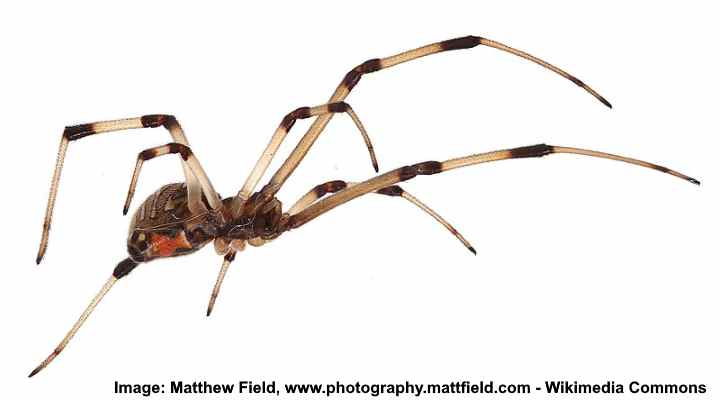
The brown widow spider has a dark striped back, striped legs and dark orange hourglass marking on its underside
The brown widow spider is a small spider with tan and brown mottled patterns on its back. Like all widow spiders, this venomous arachnid has a distinctive orange hourglass mark on the underside of its abdomen. In addition, the small biting spider has yellowish and black banded legs.
Brown widow spiders measure 0.47” to 0.60” (12 – 16 mm) long. It is found in the southern United States, particularly in Florida, California, and Texas. The brown spiders spin messy cobwebs in secluded areas such as attics, roof eaves, garages, and under furniture.
Brown widow spiders are not as aggressive as their black widow counterparts but can bite if provoked. However, the effects of their bite are less severe than black widows.
The brown widow is also a common venomous spider in Florida.
Desert Recluse (Loxosceles deserta)
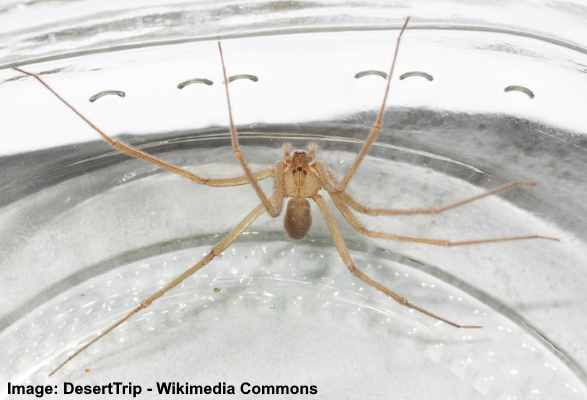
The desert recluse spider is identified by its pale brown-beige body and is commonly found in desert areas
The desert recluse spider is a brownish-yellow spider with a distinctive violin-shaped marking on its cephalothorax. The spider spends most of its time in the desert, away from human habitation. It’s a venomous spider that measures 0.23” to 0.78” (6 – 20 mm) long with a leg span of up to 2” (50 mm).
The desert recluse spider is commonly found in the southwestern United States, particularly in desert regions. Despite being a venomous spider, bites are rare because they avoid humans.
It’s good to remember that other brown spiders have a similar violin-shaped marking on their head area. Therefore, looking at its markings is not the best way to identify this spider species. Also, unlike most other brown spiders, recluse spiders have six eyes, not eight.
Noble False Widow (Steatoda nobilis)
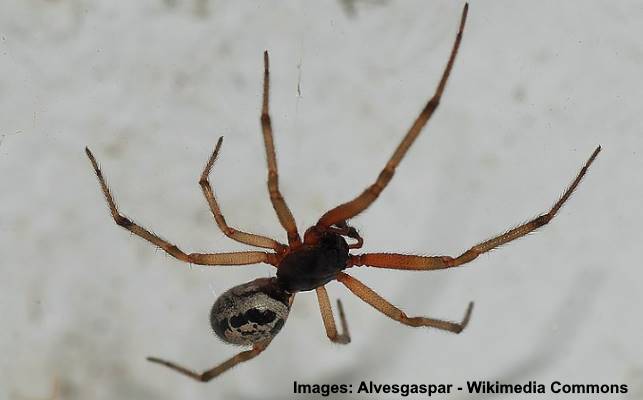
The noble false widow can be recognized by its gray and black mottled pattern on its bulbous abdomen and reddish-brown legs
The noble false widow is a large spider with a distinctive bulbous abdomen and chocolate brown or dark plum body. Identifying features of the spider are its gray and black mottled pattern on the abdomen, dark head, and reddish-brown legs. Females are larger than males and can grow up to 0.55” (14 mm) long.
The noble false widow spider is invasive along the southern coastal regions of California. Although the dark-colored spider bites, the effects are no more serious or painful than a bee’s sting.
This invasive species resembles the related false black widow (Steatoda grossa). However, it is larger, and the spider has more white dots on its black abdomen.
Western Black Widow (Latrodectus hesperus)
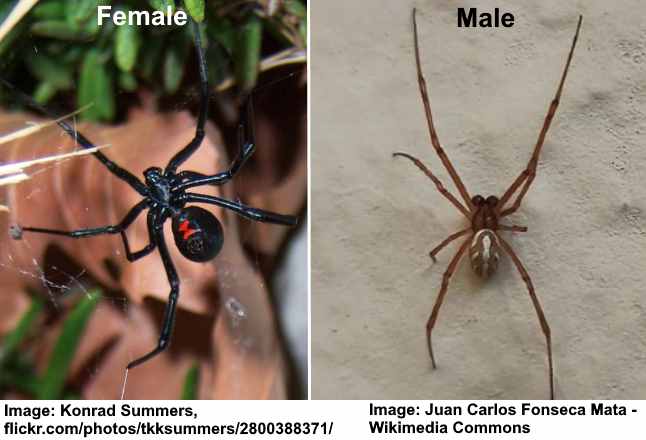
Western black widow spiders: female (left) and male (right)
The western black widow is a venomous spider identified by its shiny black body and distinctive red hourglass marking on its abdomen. The females measure 0.55” to 0.63” (14 – 16 mm) and are larger than the males. Some western black widows look brown with red triangular markings pointing at each other. The males however look completely different, with slender brown-tan bodies and silvery markings.
The western black widow is found throughout California—in hot, dry climates to mountainous terrain. The nasty spiders find their way to yards and indoors. Their favorite hiding places are in woodpiles, rock crevices, cracks in walls, and garages. However, they rarely live in homes.
A classic sign of western black widow activity is messy, irregular cobwebs near vents, doors, and other places insects tend to go.
American House Spider (Parasteatoda tepidariorum)
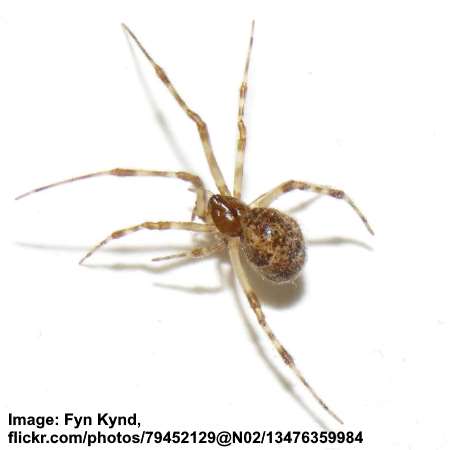
The American house spider is commonly found indoors and is identified by its bulbous brown mottled body and long legs
The American house spider is a small, brownish spider with a rounded abdomen and long, thin legs. The spider is identified by its brown and tan mottled patterns on its abdomen, a shiny brown head, and brown bands on its tan-colored legs. The females grow 0.20” to 0.24” (5 – 6 mm) long.
The American house spider is commonly found in homes throughout California. Unlike some other brown spiders, these arachnids are not aggressive and rarely bite humans. Instead, they are typically more of a nuisance pest due to the messy webs they spin in corners, closets, and other dark areas.
However, the common house spiders are beneficial in the home because they feed on flies, ants, wasps, and mosquitoes.
California Ebony Tarantula (Aphonopelma eutylenum)
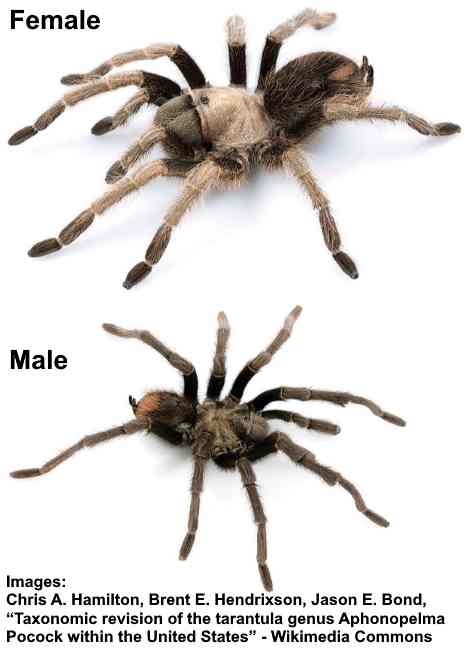
California ebony tarantula spiders: female (top) and male (bottom)
The California ebony tarantula is a large, hairy spider with a fuzzy body and legs in shades of brown and ebony. The brown and tan spider has a huge leg span of up to 5” (130 mm). Compared to the females, the male ebony tarantulas are smaller, less stocky, and dark brown with an orange patch above their spinnerets.
The California ebony tarantula is found in the deserts of California, Nevada, and Arizona. Despite their intimidating appearance, California desert tarantulas are not dangerous to humans. Instead, they tend to be shy and scurry away if you approach them.
Other tarantulas common in California’s deserts include the desert blonde tarantula (Aphonopelma chalcodes), desert tarantula (Aphonopelma Iodius), Aphonopelma joshua, and the Mojave dwarf tarantula (Aphonopelma mojave).
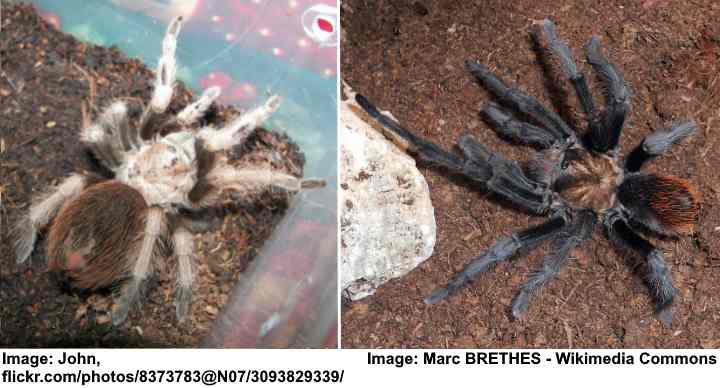
The desert blond tarantula spiders (Aphonopelma chalcodes) are also common in California’s deserts. In the pictures: female (left) and male (right)
Bold Jumping Spider (Phidippus audax)
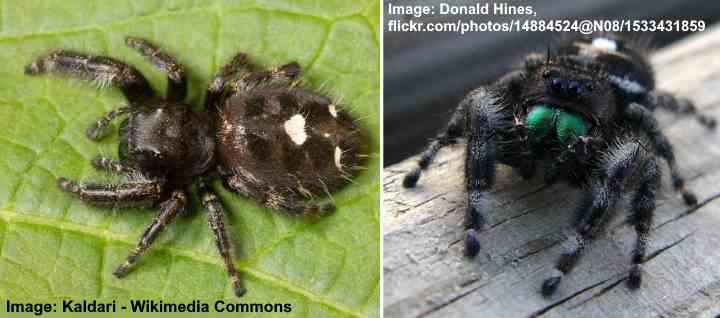
The bold jumping spider is identified by its black hairy body and 3 white or red spots on its back
The bold jumping spider is a small, compact spider with a stocky, hairy body, short legs, iridescent chelicerae, and large eyes. The hairy spiders are easy to identify due to their round cephalothorax and black egg-shaped abdomen with white or red heart-shaped spots—one large and two smaller.
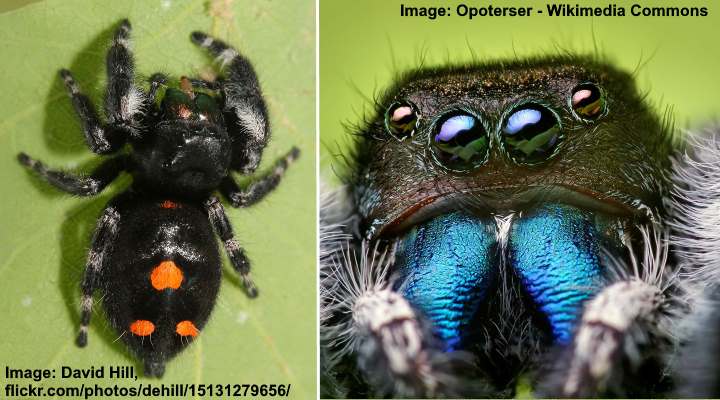
The bold jumping spider can also have orange-red spots on its back
As their name suggests, the native spiders are known for their impressive jumping abilities. The small black spiders measure 0.15” to 0.70” (4 – 18 mm) long.
Although they look menacing, jumping spiders are not considered dangerous to humans. Instead, they are beneficial creatures because they feed on common garden pests like beetles, weevils, and leaf worms.
Long-Bodied Cellar Spider (Pholcus phalangioides)
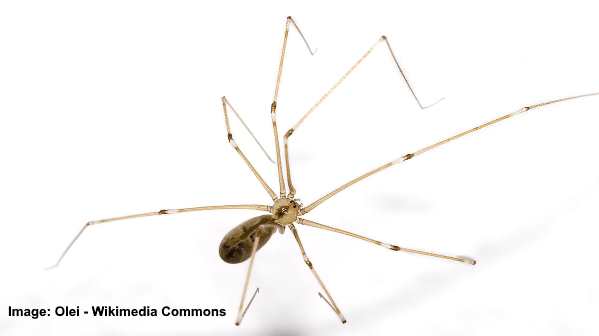
The long-bodied cellar spiders are common house spiders with long legs that like to live in dark places
Also called the daddy long-legs spider, the long-bodied cellar spider is a common arachnid found in Californian homes. The brown spider has a slender, tear-shaped abdomen and a small head. The cellar spider measures 0.31” (8 mm) long, and its long, thin spindly legs measure up to 2” (50 mm) in length.
Long-bodied cellar spiders are also called skull spiders. This name alludes to the distinctive pattern on its cephalothorax, resembling a human skull. Although the spiders aggressively hunt insects and other venomous spiders like the redback spider, they are completely harmless to humans.
California Titiotus Spider (Titiotus californicus)

A picture of Titiotus spider (Titiotus sp.). The California titiotus spider can vary in color from lighter to darker brown
The California titiotus spider is a small, brown spider with a huge leg span of up to 3” (75 mm). Some species have a prominent violin mark on their brown bodies. This makes the small brown spider easy to mistake for a desert recluse, brown recluse, or common house spider. It is one of the most common spiders found in California homes.
Although the spider can bite, its venom is not considered dangerous to humans.
Silver Garden Orbweaver (Argiope argentata)
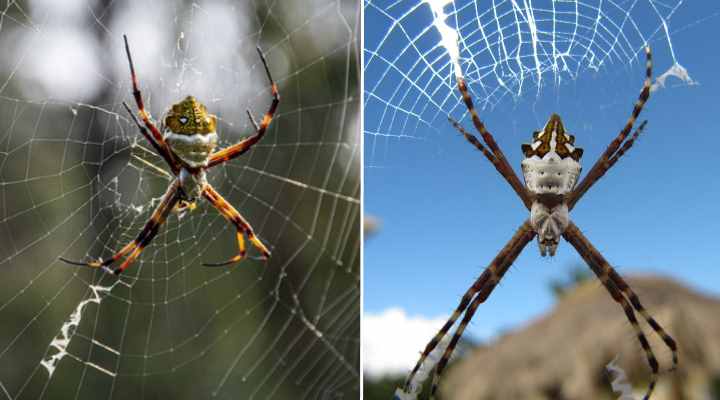
Silver garden spider: ventral and dorsal views
The silver garden orb-weaver spider is a large, striking spider with a brown body and yellow and creamy-white markings on its abdomen. The female spider measures 0.47” (12 mm)—three times larger than the male. However, its long, outstretched legs with a span of 3.5” (90 mm) make the common garden spiders appear larger.
These spiders are most commonly found in gardens and wooded areas in California, Florida, and Texas. The eye-catching spiders are known for their large, circular webs reaching up to 3 ft. (1 m) in diameter. In addition, the webs are often decorated with a distinctive zigzag pattern, known as a stabilimentum, which is thought to help camouflage the spider.
Black and Yellow Garden Spider (Argiope aurantia)
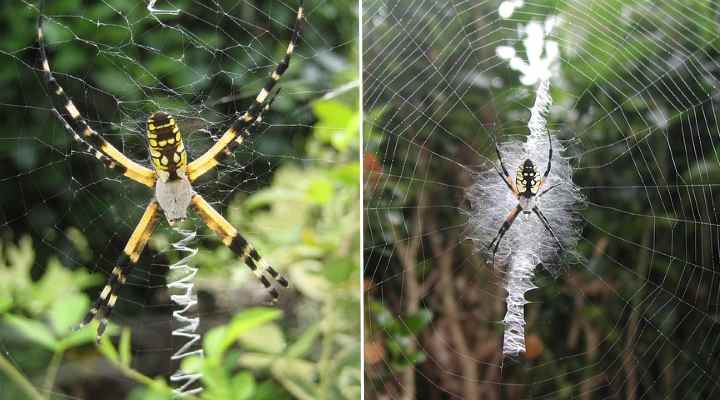
The black and yellow garden spider is commonly found in California gardens
The black and yellow garden spider is a large and striking arachnid with a distinctive black and yellow coloring. The spider’s identifying features are its egg-shaped black bulbous abdomen with yellow spots and black and yellow banded legs.
Also called the gilded-silver face spider, the females grow up to 1.10” (28 mm) long, with the males three times smaller. This common garden spider is often seen in yards in California. The spiders spin large orbital webs up to 2 ft. (0.6 m) in diameter with a distinctive zigzag pattern in the center.
Hobo Spider (Eratigena agrestis)
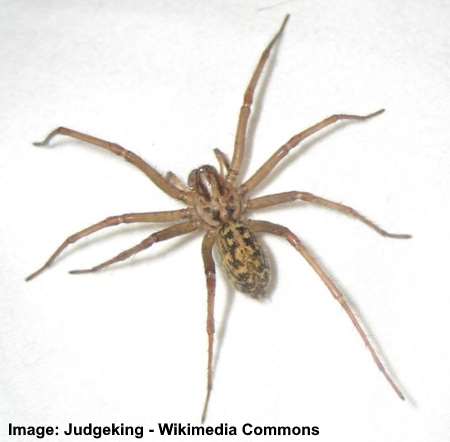
The hobo spider has light brown body with dark markings and long legs
The hobo spider is a small brown spider with a characteristic herringbone pattern on its abdomen. The pale brown spider also has identifying features of two lines on the cephalothorax, chevron markings on its abdomen, and eight brown legs. Adult hobo spiders measure 0.27” to 0.55” (7 – 14 mm) long.
Because of its light brown color and distinctive markings, it’s easy to mistake the hobo spider for a brown recluse spider. However, unlike the hobo spider, the brown recluse isn’t found in California.
Hobo spiders are not dangerously venomous spiders. However, some reports suggest that their bite causes skin necrosis. But, the bites are more likely from the similar-looking desert grass spider (Agelenopsis aperta), also commonly found in outdoor spaces in California.
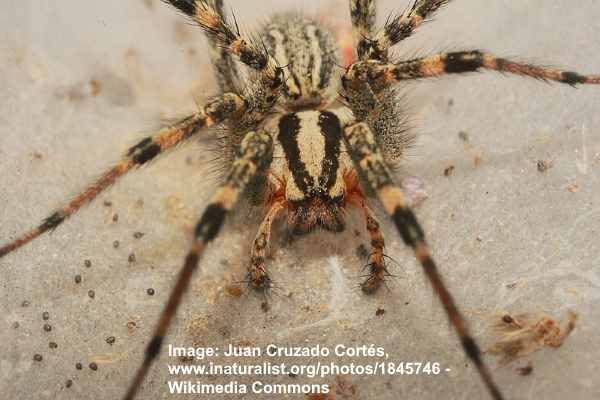
Desert grass spider (Agelenopsis aperta)
Carolina Wolf Spider (Hogna carolinensis)
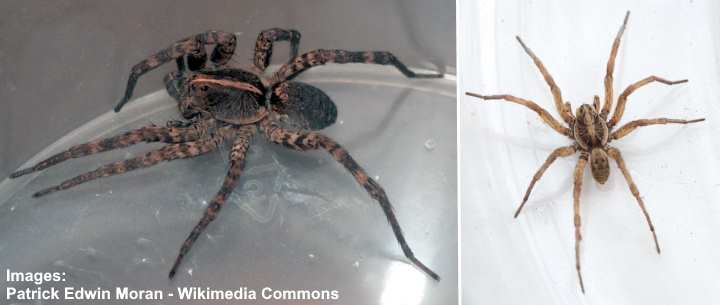
Carolina wolf spiders: female (left) and immature male (right)
The Carolina wolf spider is the largest type of wolf spider in California. The large female fuzzy spider has a hairy, dark brown body with a distinctive pattern of tan stripe on its cephalothorax. It also has long, powerful legs, giving it the ability to run fast.
The hairy brown spider can grow to 1.38” (35 mm) in size. Despite its menacing appearance, the Carolina wolf spider is not aggressive toward humans and will generally only bite if provoked or threatened.
The Carolina wolf spider is found throughout the southeastern United States, where it prefers to live in grassy areas hunting small insects and invertebrates.
Cross Orbweaver (Araneus diadematus)

Cross orb-weaver spider: female (left) and male (right)
The cross orb-weaver spider is a distinctive orange spider with a white cross-like pattern on its abdomen. Identifying features of this unusual spider are its yellow and orange banded leg covered in spines, a small head, and two orange chelicerae. The orange cross orb-weaver spider measures 0.26” to 0.79” (6.5 – 20 mm) long.
The cross orb-weaver spider is commonly found in southern gardens, meadows, and wooded areas in the southwestern United States. These web-spinning orange spiders catch prey in their large, wheel-shaped ornate webs.
Yellow Sac Spider (Cheiracanthium inclusum and Cheiracanthium mildei)
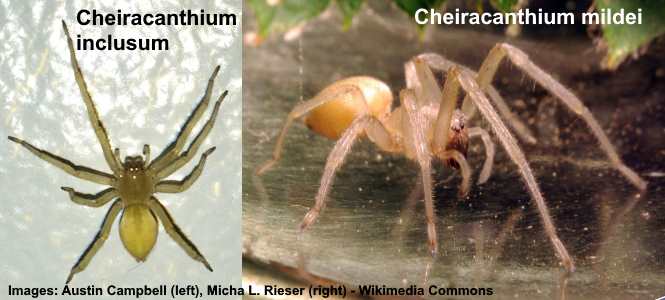
Yellow sac spiders are commonly found in California gardens, but come inside homes in cold weather
The yellow sac spider is a small, pale yellow to light brown spider with a cylindrical body and long legs. It lacks distinctive markings but has recognizable large chelicerae and dark brown palpi. Sac spiders measure up to 0.37” (9.5 mm)
The two species of sac spiders found in California are the American yellow sac spider and the northern yellow sac spider. These common house spiders spin flat silk sacs where they spend most of their time. The small spiders can bite, but the effects are less severe than brown recluse spiders.
Gray House Spider (Badumna longinqua)

The gray house spider is identified by a black body covered in fine gray hairs and is common in California
The gray house spider is a common spider found in California. The medium-sized spider has a dark gray to black body covered in fine gray hairs giving the bulbous abdomen a lighter appearance. The black spider has faint grayish bands around its legs. Adult females grow up to 0.60” (15 mm) long.
Black house spiders are known for building messy webs in dark corners, crevices, cracks in window frames, and air vents. They are also known to prey on insects, ants, moths, and other spiders.
Crab Spider (Misumena vatia)
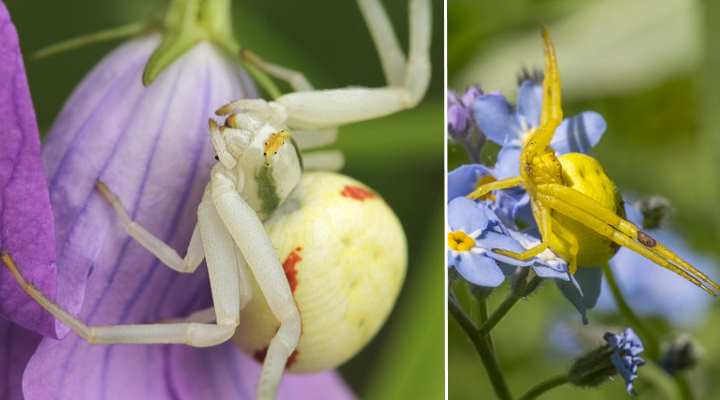
The crab spider can be white or yellow with oval short body and crab-like legs
The crab spider is one of the most unusual white spiders in California. The identifying features of the crab spider are its ball-like body, crab-like legs, and yellowish-white body with reddish markings. However, depending on the color of the flower where the small garden spiders hunt, the spiders can be white or yellow.
Adult female crab spiders measure 0.23” to 0.39” (6 – 10 mm) long. The spider gets its name from its crab-like appearance and ability to walk sideways and forward.
The crab spider is an ambush predator found on the flowers of many species of California plants. These unusual spiders wait to capture and feed on large insects like bumblebees, wasps, butterflies, dragonflies, and moths.
False tarantula (Calisoga longitarsus)
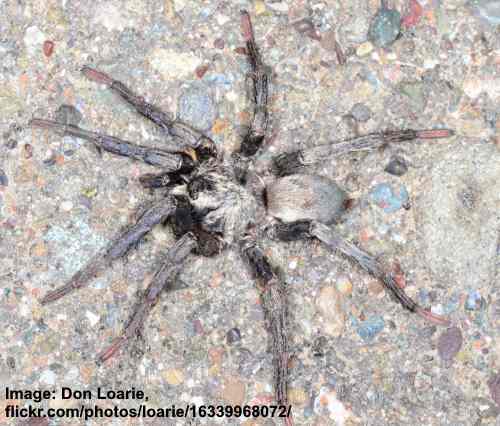
The large false tarantula can vary in color from silvery gray to brown
The false tarantula is a large and intimidating spider with a silvery-brown appearance. The large arachnid has a sizable egg-shaped abdomen, a large head area, and long, robust hairy legs. These characteristics give the spider the appearance of a tarantula. However, it’s a member of the funnel-web spider family Nemesiidae.
The dark brown or gray spider has a hairy appearance, and its leg span can measure up to 2” (50 mm). Like tarantulas, they spend most of their time in burrows, making them difficult to spot outdoors. However, these tame, harmless tarantula-like spiders are popular pets due to their docile nature.
Related articles:
